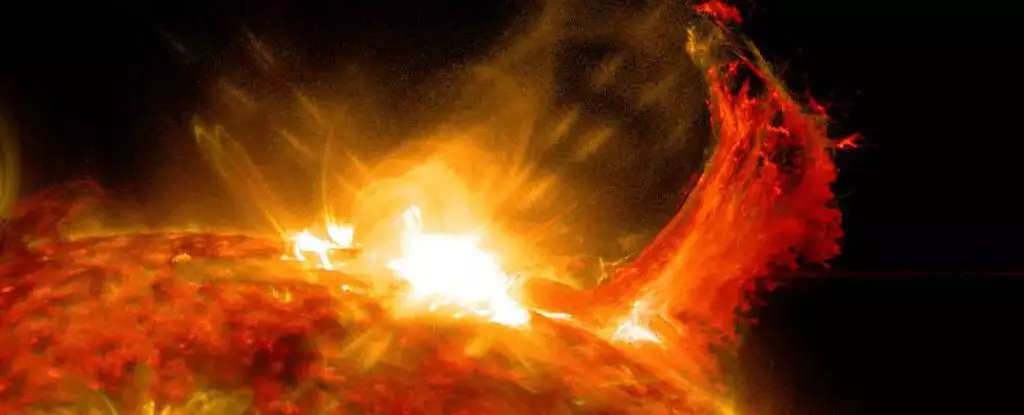The Sun, often perceived as a stable and reliable force in our Solar System, is far from tranquil. As a gigantic ball of gas undergoing constant nuclear fusion, it exhibits dynamic activity that resembles a cauldron of roiling convection. Magnetic fields flicker erratically, producing a series of powerful solar phenomena—from violent flares to expansive coronal mass ejections (CMEs). While these events generally do not pose a direct threat to Earth, the increasing evidence suggests that the frequency and potential impact of significant solar flares should not be underestimated.
Solar flares and CMEs are manifestations of intense energy release on the Sun’s surface. These eruptions can propel charged particles toward Earth, possibly disrupting satellite operations, power grids, and communication networks. While most solar activity is benign, powerful events occur more frequently than previously understood. A recent analysis that focused on 56,400 Sun-like stars indicates that our Sun may produce a superflare—a highly energetic flare—roughly once every 100 years, a revelation that raises crucial concerns about our vulnerability.
This 100-year figure is a stark contrast to earlier estimations, suggesting that the risk of a significant solar event could be much higher than anticipated. Historical events, particularly the Carrington Event of 1859, demonstrate the destructive potential of solar superflare activity. The Carrington Event, registering at only one percent of the energy of a full superflare, still caused widespread disruptions by igniting telegraph systems and resulting in geomagnetic storms.
Understanding the frequency and impact of solar flares is far from straightforward. Astronomers employ techniques such as analyzing tree rings and ice cores to gauge past solar activity, which yields information on carbon-14 spikes correlating to major solar storms. However, these methods provide an incomplete picture. The quest for continuous, precise data on solar flares includes observing G-type yellow dwarf stars similar to our own Sun. Researchers strive to capture these stars during flare events, using their activity to derive estimates of flaring frequency.
The difficulty in accurately measuring the rotation rates of these stars complicates matters further. Stars similar to the Sun that could provide valuable data often exhibit ambiguous rotation patterns. Enlightened by this, researchers have strategically expanded their approach. They include Sun-like stars with indeterminate rotation rates but comparable brightness and temperatures. This inclusion opens a broader dataset to analyze—while excluding those with shorter rotation periods, which could skew their findings.
The effort culminated in a comprehensive analysis of 56,450 Sun-like stars, resulting in the observation of 2,889 superflares. The averaged calculation from these observations yields the daunting conclusion of a superflare occurring approximately once every 100 years.
If our Sun follows these predicted patterns, the implications could be significant. The damaging effects of solar flares on high-frequency radio communications and satellite operations could escalate in severity, potentially leading to infrastructure overloads during powerful geomagnetic storms. The Carrington Event serves as a precedent, highlighting how impactful a major solar flare can be. Furthermore, in examining historical records, scientists have identified Miyake events—massive solar flare events more powerful than the Carrington Event—occurring every 1,000 years. This adds another layer of concern, prompting researchers to seek clarity on the connection between superflares and CMEs.
As the Sun continues its reign as a powerful force of nature, the relationship between solar flares and their effects on Earth requires more extensive study. Current knowledge indicates that superflares do not always generate CMEs. This variability produces uncertainty in predictions about their consequences, necessitating increased investigation to ensure modern technology is prepared for potential disturbances.
A heightened understanding of our Sun’s intricate behavior will ultimately enhance our ability to predict and mitigate against the possible fallout of solar flares. Acknowledging the potential frequency and power of extreme solar events is crucial for crafting disaster response strategies. This knowledge is especially vital for industries dependent on satellite-based technology, telecommunications, and electrical grids.
The latest findings regarding the Sun’s activity are a reminder that our Sun, while a source of light and life, also possesses a more tumultuous side. As researchers like Natalie Krivova from the Max Planck Institute for Solar System Research emphasize, grasping the full scope of solar events is indispensable for understanding how to navigate the challenges posed by our nearest star. At a time when our reliance on technology is at an all-time high, exploring this celestial powerhouse will remain a priority in solar research for years to come.


Leave a Reply